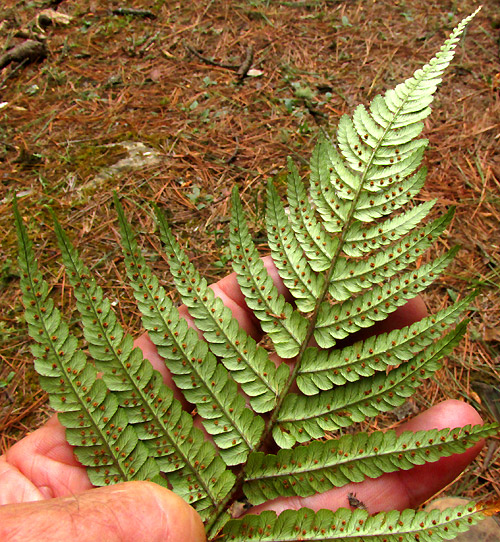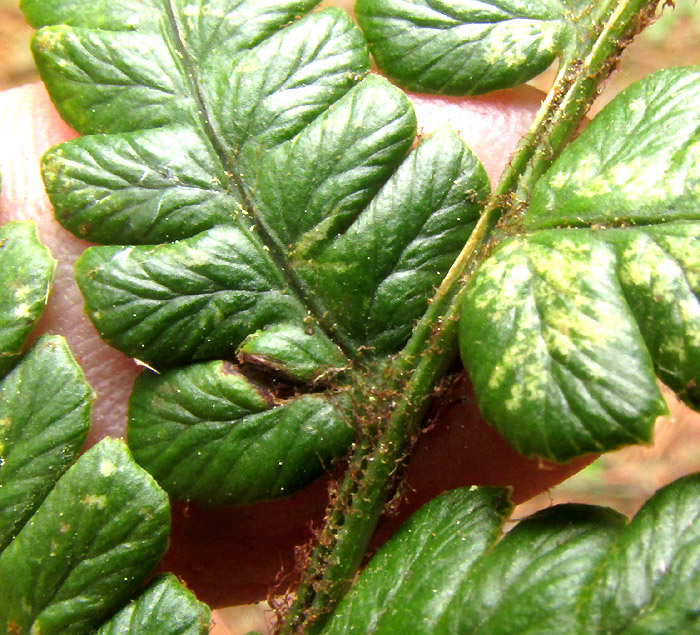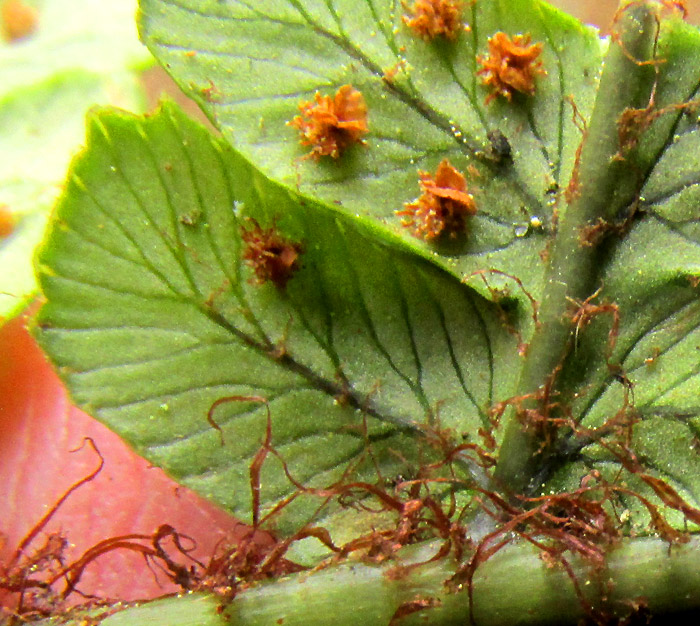Excerpts from Jim Conrad's
Naturalist Newsletter
Entry dated April 21, 2024, from notes taken about 1.5km north of La Cañada, slope above small branch road off Hwy. 120, Municipality of Pinal de Amoles; N21.125°, W99.666°, elevation ~2610 meters (~8560 feet); oak-pine on limestone bedrock; in the Eastern Sierra Madre Mountains of east-central Querétaro state, MÉXICO
ALPINE WOOD FERN

Beside trail up a steep slope through pine woods, long ago someone had dug a bathtub-size pit for unfathomable reasons, though hikers tended to throw trash into it. Now the pit's walls were populated with mosses and the above fern.

The handsome fern was one of those on which the fronds' lower pinnae gradually diminished in size toward the bottom, plus the lowest pair of pinnae swooped downward.

Fronds and their pinae gradually diminished to long, sharp tips. Above, a frond's undersurface is shown, dotted with brown, circular, spore-producing sori.

On the upper surface, veins were sunken into the somewhat leathery pinnae. The frond's midrib, or rachis, was deeply furrowed, or channeled, along its upper side, and bore tangles of dark, slender, hairlike scales. Note that the pinnae's margins are not so deeply cut that their lobes are completely separated from one another. Also, pinna lobe tips are blunt, almost squared; that's a good field mark for distinguishing this species from close relatives. Vein tips extend to pinna margins without connecting with one another to form reticulate patterns

Up close and from below, the long, dark, slender scales along the rachis also are distinctive.

Each of the four sori seen above consists of compact clusters of tiny, brown, sandgrain-like sporangia, each atop a threadlike stalk. Most sporangia have burst open, releasing their spores, leaving only stalks atop which are the remains of silvery spore cases. Like a crooked canopy, a papery, roof-like indusium spreads atop each cluster of sporangia. The side of each indusium is attached to a point on the pinna's undersurface in such a way that the indusium surface forms a horseshoe-shaped flap which is depressed at the point of attachment. These are hair-splitting details, but necessary for identification.
The above features, particularly the rounded sori with horseshoe-shaped indusia attached and depressed at a point on one side, takes us to the wood ferns, genus Drypoteris, of the Wood Fern Family, the Dryopteridaceae. In this region of upland central Mexico, if you have a Drypoteris whose pinnae tips are squared or at least blunt, and the frond rachis bears long, dark, slender scales as seen above, you have DRYOPTERIS WALLICHIANA, the Alpine Wood Fern.
Alpine Wood Ferns are native to temperate higher elevatios in the American and Asian tropics and subtropics, Hawaii, and thereabouts. Regarded as an especially attractive, semi-evergreen fern that's easy to grow, often it's planted in gardens; it's been awarded the Royal Horticultural Society's Award of Garden Merit.
The online Atlas de las Plantas de la Medicina Tradicional Mexicana reports that in Morelos state Dryopteris wallichiana is used medicinally to treat gallstones -- cálculos biliares. The 2005 study by Andrea León Parra and María Teresa Murillo entitled "Listado de especies de la subfamilia Dryopteridoideae, tribus Dryopterideae, Rumhoreae y Tectarieae (Familia: Dryopteridaceae) para Colombia," lists the species as used in Colombia as a vermifuge -- to expel parasitic worms.
In the 2004 work by John Mickel and Alan Smith entitled "The Pteridophytes of Mexico," it's remarked that in the Americas Dryopteris wallichiana appears to be an apogamous triploid (having an extra set of chromosomes along with the usual pair, in a species in which the fern body develops without sexual union) or a tetraploid (having four sets of chromosomes instead of two), while in the Old Word they are apogamous diploids (having the usual pair of chromosomes, though still the frond develop without sexual union). Ferns in general are famous for their genetic acrobatics.